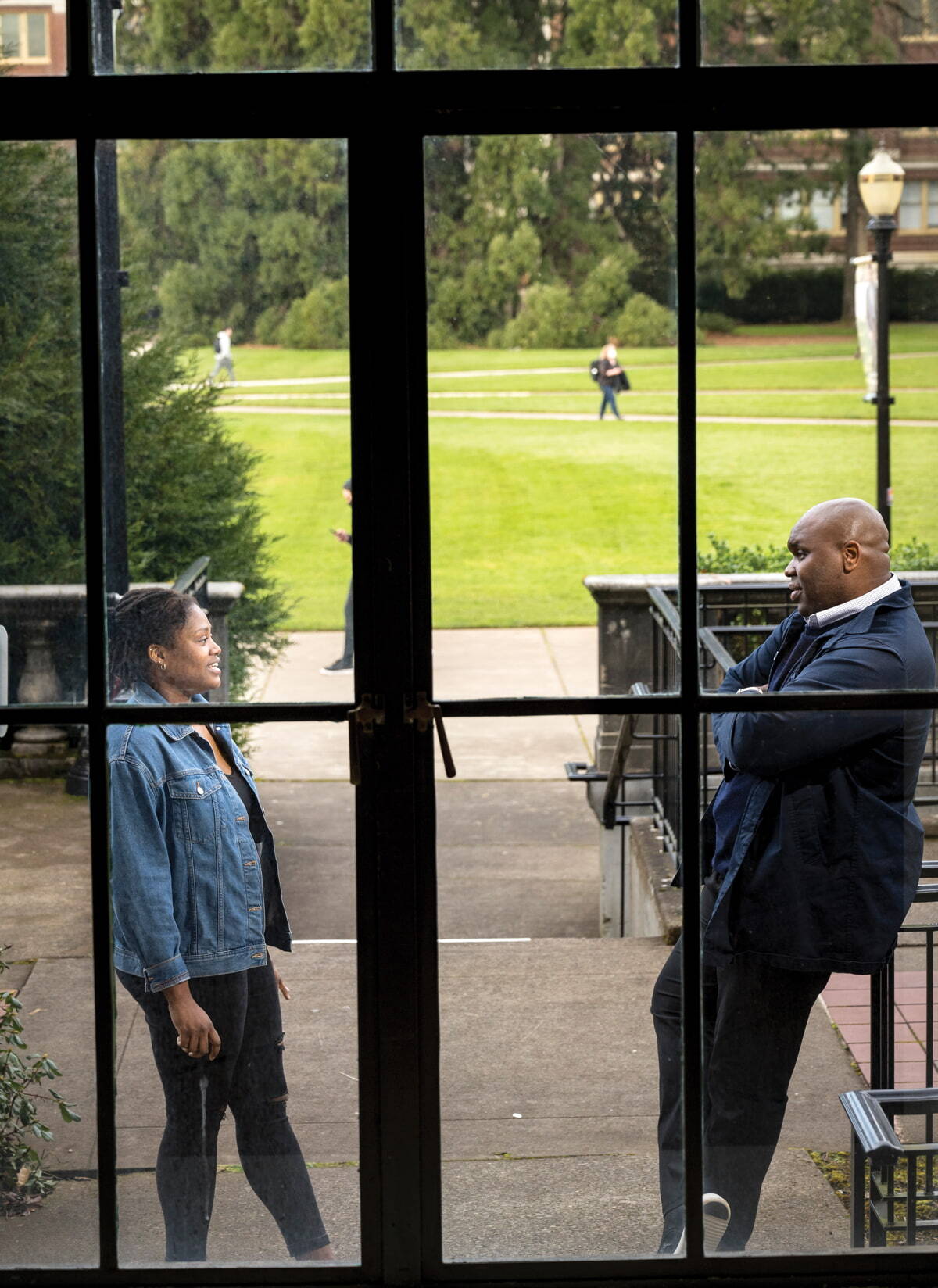For Dorian Smith, ’09, M.A.I.S ’17, helping OSU increase the diversity of its student body isn’t just a job. It’s an opportunity to walk beside students who are following in his footsteps.
A standout defensive end as a Beaver student-athlete, Smith has worked for the university’s Educational Opportunities Program since 2016. He recently became director of the new Griggs Center for Black and Indigenous Student Success.
Once students are enrolled and have started their studies, he connects them with programs that help them find community and make the most of their time at OSU. But his first step is to encourage Black, Native American, Pacific Islander and Alaskan Native students to commit to OSU in the first place.
Students of color now make up more than 28% of OSU’s overall enrollment, a percentage that’s doubled in a decade. However, less than 2% of students at the Corvallis campus identify as Black. (About 2% of Oregon residents identify as Black.) To grow the percentage at OSU, Smith works to build trust in Black communities across Oregon, providing prospective Beavers with guidance on everything from which high school classes to take to how to fill out financial aid forms.
He also connects with out-of-state students like Le’Waski Watkins of Tuscaloosa, Alabama. Passionate about hemp research, Watkins contacted the head of OSU’s Global Hemp Innovation Center for information and soon received an email from Smith.
“Before I took my first class — before I even had my schedule — he was sending me all these resources, everything I needed. I was blown away,” said Watkins, a junior double major in horticulture as well as crop and soil science. His transition from Alabama to Oregon was hard and lonely at first.
“But I always had Dorian,” Watkins said. “He gave me tips about how he coped when he first came here, to help me be more comfortable. He gave me his phone number and said, ‘Call me if you need anything.’ In fact, if I don’t check with him, he’s going to check in with me.”
The university is expanding its programs for underrepresented students. In fall 2020, OSU opened two living-learning communities on the Corvallis campus that center on the experiences of Indigenous people and those with Black and African American identities. These communities are open to all students.

For Vanessa Sellers of Tulsa, Oklahoma, the Nia Black Scholar Living-Learning Community was key to her choice to come to Oregon State. In addition to living together at Poling Hall, Nia residents have the opportunity to take an African American studies class together. For many, it might be their only OSU class with more than one Black student. “Having the hall helps a lot. We have a lot of events together,” Sellers said.
Smith noted that strong communities and great advice are important but can’t help students who can’t afford their OSU experience.
“We know the pandemic has had disparate impacts on the Black community,” Smith said. “This year I have had more emails and calls from students with financial holes, students taking a gap term, students struggling to come back and finish their degree because of financial reasons.”
The OSU community is responding, and opportunities for alumni and friends to get involved are growing as the OSU Foundation and OSU Alumni Association increase efforts to secure financial support and build communities that promote lifelong success. Between 2019-20 and 2020-21, philanthropic gifts for diversity, equity and inclusion initiatives at Oregon State more than doubled, and the number of participants in identity-based OSU alumni groups grew by 300%.
That matters for students like Watkins, who considered dropping out during his first year because he was running out of money. “I reached out to Dorian and said, ‘I’ve got this balance on my account.’ A little while later, he told me to look at my account and the balance was not on it. I don’t know how, but he made it happen.”
More support is on the way, including some from Timothy Moriarty and Arthur Anderson, ’77. Strong proponents of increasing opportunities for Black communities through education, the couple spent years looking for a place where their estate gift, expected to exceed $1 million, would make a real difference. When they learned about Smith’s work and OSU’s three-pronged approach of investing in student recruitment, retention programs and financial assistance, they knew they found the right fit, and structured their gift to support all three areas.
“We would like to have other people join us in helping build a better community in Oregon, our home, and help offset the injustices of the past,” Anderson said. To that end, the couple is also providing annual challenge gifts, hoping to see measurable growth in OSU’s Black student population within their own lifetime.
After earning doctoral degrees in plant pathology and soil microbiology at OSU, Anderson worked more than 40 years as a leader in the nursery industry. He served as the first president of the Oregon Garden Foundation when the much-loved botanical garden was founded in Silverton.
Moriarty, who left school at age 16, achieved so much success as a high-end Boston hairdresser and business operator that he retired at age 52. “I was born poor – financially and also culturally,” he said. “So when I became successful, I thought, ‘Wow, I hope I can give somebody else an opportunity.’”
Watkins remains grateful for the support he has received and for Smith’s mentorship.
“I call OSU the land of opportunity,” he said. “OSU is a very nurturing school, a great place to learn. A place that gives me a chance to prove myself.
“Much as I love the school,” Watkins added, “if it wasn’t for Dorian, I don’t know if I’d still be a Beaver.”
To learn more about supporting diversity, equity and inclusion efforts at OSU, contact Mike Moran: Mike.Moran@osufoundation.org, 503-201-0185.
Photo: Dorian Smith mentors many students like Vanessa Sellers and Le’Waski Watkins. “As the years have gone by, I’ve gone from feeling like a big brother to being like an uncle,” he said. “Eventually, I’ll be more like a granddad. It’s cool to have these relationships and know what students are going through in their day-to-day lives.” (Photo by Karl Maasdam)
This story originally appeared in the Spring 2022 Oregon Stater magazine.

